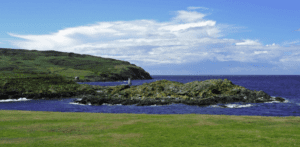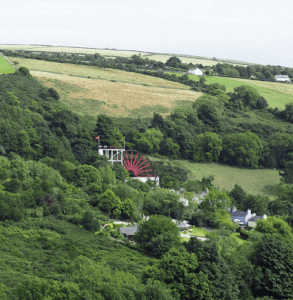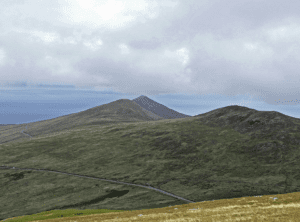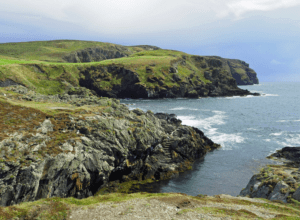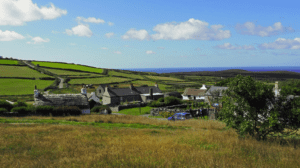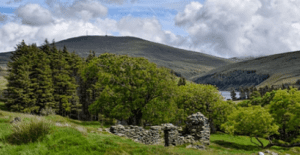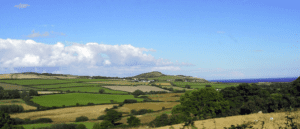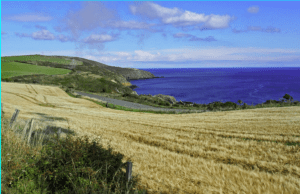The Isle of Man sitting in the middle of the Irish Sea isn’t very large – 30 miles by 10 miles but it punches way above its weight. It has the lot from rocky coastlines, sandy beaches, wooded glens, bare swept mountains and fertile farmland. And that is before you add in the history and culture.
The island was settled from the Stone Age and there are the remains of stone circles. The early Celtic missionaries arrived in the C5th building tiny keeils across the island and their remains can still be found. Christian burials were marked by a carved stone. The earliest were a simple carved cross but gradually these became more elaborate with beautifully carved wheel heads and shafts. The wheel cross in the churchyard of Old Lonan church is still standing where it was first erected 1500 years ago. The remains of other crosses can still be found in churches around the island.
The Vikings arrived in the C9th, first as raiders but later settled and married the local Celts. They were buried in ship burials like that at Balladoole near Castletown. Gaelic remained the language of the home but the Vikings introduced Norse place names and government. “Tynwald”:http://wasleys.org.uk/eleanor/man/page_three/index.html is the oldest parliament in the world. You can join in a debate in thee old House of Keys in Castletown or join a guided tour around the Tynwald building in Douglas.
There is history everywhere you look. “St Patrick’s Isle”:http://wasleys.org.uk/eleanor/man/central/patrick_isle/index.html is the site of an early Christian settlement, the original cathedral and also a castle. “Castle Rushen”:http://wasleys.org.uk/eleanor/man/south/castletown/castlerushen_one/index.html is one of the best preserved Medieval castles in Europe. There may not be much left of “Rushen Abbey,”:http://wasleys.org.uk/eleanor/man/south/rushen_abbey/index.html but the gardens are a lovely place to drop out on a sunny day.
“Cregneash Folk Museum”:http://wasleys.org.uk/eleanor/man/south/cregneash/index.html on an isolated plateau in the south of the island was the last place Manx language survived into the C20th. The buildings have been carefully restored to depict life a hundred years ago.
There is also the industrial heritage too with the remains of lead mines all over the island. The biggest and most profitable was the “Great Laxey Mine”:http://wasleys.org.uk/eleanor/man/north/laxey/mine_one/index.html with its impressive waterwheel used to keep the mine free of water. The “Lady Isabella Wheel”:http://wasleys.org.uk/eleanor/man/north/laxey/mine_two/index.html is still the largest working waterwheel in the world.
Fishing, especially for herring was also important and there is still a traditional smoke house in Peel. Smoked over wood chippings their kippers are out of this world and completely different to the mass produced offerings on sale in the supermarket.
When the Isle of Man Steam Packet began running regular steam ship services in the C19th, the island quickly became a major holiday resort for Victorian visitors who arrived in their hundred of thousands every year. Railways were built to open up the island to tourism and small fishing villages soon developed into major holiday resorts with splendid hotels built to accommodate them.
Tourist numbers never recovered after the Second World War and the island became much more dependent on the financial industry for wealth. Only the annual TT races brought visitors to the island.
The Manx Government promoted 1993 as the ‘Year of Railways’ which attracted transport enthusiasts of all ages to the island. This put the Isle of Man back on the tourist map and visitor numbers have increased as people have discovered the island. Douglas, the capital is still the major holiday resort, closely followed by Port Erin with its sandy beach and Peel, often referred to as the sunset city. As well as these, there is Ramsey which is largest town in the north of the island and Castletown in the south which was the original capital and was relatively untouched by Victorian tourists.
The Isle of Nan is a haven for wildlife with sightings of basking sharks, dolphin and seals. It is also popular with walkers with three long distance footpaths and shorter walks through the wooded glens.
For those wanting more high adrenaline activities there is surfing, Kayaking, abseiling, gorge walking.
The island is a mecca for motorcyclists. As well as the TT there are also many other opportunities for bikers to test their machines to the extreme during the year. Roads are closed when races take place and speeds can reach up to 200mph and it is pretty scary – and that is for the spectators!
There is also an excellent bus service that provides a frequent service to all parts of the island from early morning to late evening. Go Explore Cards give free transport on all buses, trains and trams.
The Isle of Man really does cater for everyone AND finally, don’t forget to say “hello’ to the Little People when you cross the Fairy Bridge on the A5…
You can read all about the two weeks I spent exploring the island “here.”:http://wasleys.org.uk/eleanor/man/index.html
